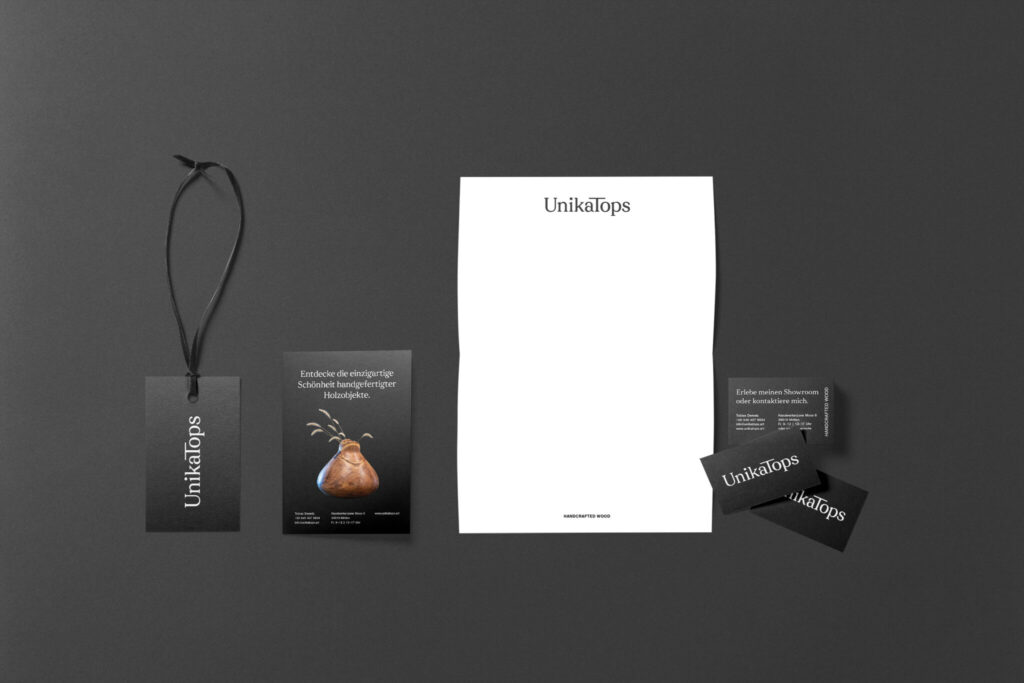Every interaction people have with your brand is an opportunity to build a relationship and leave a mark. As markets get increasingly saturated, an outstanding brand experience can make all the difference. And this is exactly where your brand touchpoints come into play.
By the end of this article, you’ll understand:
- What brand touchpoints are
- Why they matter
- Types of brand touchpoints
- Their role in the customer journey
- How they are different from brand assets
- How to create effective brand touchpoints for your company
- Brand touchpoint examples to inspire you
What Are Brand Touchpoints?
Brand touchpoints include every interaction a person can have with your brand, whether within your control or beyond. These contact points influence people’s experiences with and perceptions of your brand.
Brand touchpoints can take different forms. They can be physical, like a storefront or business card, and digital, such as email newsletters or social media posts.
They can even occur in person, like interactions with service representatives or live events.
The purpose of each touchpoint can vary greatly. Some aim to inform your audience, others address their objections, and yet others create meaningful connections.
However, all brand touchpoints have one thing in common: each is an opportunity to shape people’s attitudes towards your brand and convince them your offer is the right fit for them.
The 7 Touchpoint Rule
The ‘7-touchpoint rule’ suggests that people need about seven interactions with your brand before they feel confident about buying. In other words, they should face at least seven different brand touchpoints.
Why does this matter? It takes different stages to introduce your offer and company, address potential objections and guide people through their decision-making process.
The key is to offer diverse but consistent experiences. This helps build trust, create a positive perception, and, ultimately, turn leads into customers.
Why Brand Touchpoints Matter
Here’s a breakdown of why your brand touchpoints are so valuable:
Setting the Tone with First Impressions
The first interaction someone has with your brand, whether through your website or an ad, significantly influences their overall perception of your company.
This happens due to the Halo Effect, where one positive aspect leads to a favourable overall judgement.
Think of these early touchpoints with your brand as the first chapter of a book, which sets the tone for everything that follows.
Thus, your brand touchpoints allow you to make a strong impression right from the start.
Creating a Distinctive Identity
Your brand touchpoints also help you establish a consistent and recognisable brand identity. You can achieve this by consistently using your key brand elements, such as your logo, brand fonts or tagline.
Repeating these distinctive brand assets helps them get firmly anchored in people’s minds and make your brand unmistakable.
A consistent look and feel also helps to convey the essence and personality of your brand—what it stands for and feels like. As a result, it attracts people who have similar values and beliefs.
Creating Branded Experiences
Whether consumers choose a brand often depends on their experience with it. Brands that offer exceptional customer experiences generate 5.7 times more sales than competitors that don’t.
Brand touchpoints play a crucial role in shaping these experiences, for example, through attractive events, helpful content, funny ads and a professional overall image.
Fostering Customer Loyalty
Consistent and positive experiences encourage customer loyalty towards your brand. This goes beyond mere satisfaction—every interaction with your company should be considered and meaningful.
The aim is to build trust and encourage active participation and loyalty.
A seamless customer journey across all touchpoints increases the likelihood of your customers becoming avid fans.
Take Johnny Cupcakes, for example. The fashion label is known for creating surprises across all its touchpoints.
With the help of exclusive releases, original interiors and creative content—all bakery-themed—Johnny Cupcakes has built a loyal base of enthusiastic fans.
Effective Marketing and Communication
The strategic use of brand touchpoints can address challenges, concerns, or doubts that may stand in the way of a sale in advance.
At the same time, these touchpoints help deliver your message clearly and consistently.
Gaining a Competitive Advantage
In a highly competitive market, consistent brand touchpoints emphasise your brand’s uniqueness and signal that customer satisfaction is a priority for your company.
Gathering Feedback and Insights
And finally, brand touchpoints are not just about a one-way flow of information.
Surveys or quizzes are a great way to gain insights into the customers’ preferences and challenges.
This feedback loop allows you to adapt and improve your offering and communication.
The 4 Types of Brand Touchpoints
There are many ways a brand touchpoint can look like. Let’s break it down into four types:
Physical Brand Touchpoints
Physical brand touchpoints include all interactions a person can have with your brand in the real world.
Examples:
- In-store experiences (layout, ambience, service)
- Product packaging
- Trade shows and events
- Branded merchandise
Digital Brand Touchpoints
Digital touchpoints include all online interactions that shape your brand presence in the virtual space.
Examples:
- Website
- Social media platforms (Facebook, Instagram, LinkedIn)
- Email marketing
- Online advertising
Communication Touchpoints
Communication touchpoints relate to how a brand conveys its message.
Examples:
- Advertising (TV, radio, print)
- Public relations (press releases, media coverage)
- Customer service interactions
- Content Marketing (blog posts, social media posts)
Human Touchpoints
Personal or human touchpoints include direct interactions with the people who represent your brand.
Examples:
- Employee interactions
- Customer support (phone, chat, in-person)
- Sales representatives
- Support technicians
Brand Touchpoints in the 5 Stages of the Customer Journey
Talking about brand touchpoints, there is no way around mentioning the customer journey.
The customer journey describes all the phases a customer goes through when interacting with your brand. It ranges from initial awareness to post-purchase loyalty.
If you understand your customers’ journey, you can strategically develop the touchpoints with your brand for each phase—a process called customer journey mapping.
Let’s break down the customer journey into its five phases:
Awareness
In the awareness stage, potential customers discover your brand and its offerings.
Typical touchpoints at this stage might include ads, blog posts, or word-of-mouth recommendations.
Consideration
As customers contemplate a purchase, their interactions become more detailed. Now, they seek a better understanding of your company and its products or services.
This may involve visiting your website, reading your brochure or studying product reviews.
Decision-Making
The decision-making stage is pivotal, ultimately deciding whether a person chooses your product or a competitor’s.
During this phase, people may interact with touchpoints such as your website or a salesperson to gather all necessary information.
They might also read customer reviews, watch product demonstrations, or send personal messages, such as emails, to inform their final decision.
Purchase
When people reach the purchase stage, it’s not the finish line.
Even here, they encounter brand touchpoints—like navigating through your online checkout, completing in-store transactions, or doing whatever it takes to complete their purchase.
Post-Purchase Engagement
One misconception is that the customer journey ends with a sale.
If people have bought from you before, chances are they’ll do it again. So, it’s a good idea to keep the connection going.
Engaging with your clients after they buy from you has another advantage: you can collect customer feedback and continue to optimise your offer, communication and marketing.
Post-purchase engagement may involve sending follow-up emails and questionnaires, offering personalised recommendations or sending birthday cards.
By aligning your brand touchpoints with the five stages of the customer journey, you can create a holistic brand experience that nudges people to buy from you confidently.
While aligning your brand touchpoints with the customer journey is worthwhile, remember real-life buying behaviour is often emotional and non-linear.
People might impulsively buy on first exposure. Or they might take years to decide they need your product or service.
The customer journey is a helpful framework but does not rigidly dictate every interaction.
Brand Touchpoints vs Brand Assets
If you read my previous article on brand assets, you might wonder: What’s the difference between brand touchpoints and assets?
Although brand touchpoints and assets are related, they are not the same.
Brand assets are the visual, verbal, or other sensory cues that define and distinguish your brand—think of your logo, brand colours, a catchy jingle, or a unique packaging shape.
These brand assets contribute to immediate brand recognition. However, they don’t exist in isolation; they are applied throughout your brand touchpoints.
In a nutshell, Brand assets are the distinctive signals that make your brand recognisable and unique, and brand touchpoints are the moments where these signals are expressed and come to life.
Creating Effective Brand Touchpoints
1. Understand Your Customer and Their Journey
To create effective brand touchpoints, put yourself in your customer’s shoes first.
- Where do they spend their time?
- What communication channels do they use?
- What do they need from you (and when)—is it emotional support, information, or a fun experience?
- Remember that different customers may have different needs and expectations. It may help you to categorise them into various groups, such as cold leads, warm leads, and new and existing customers.
What do these people need specifically?
Think about which type of touchpoint best suits your audience. For example, a busy professional looking for financial advice might prefer a short video to a long blog article.
It can be helpful to think through the customer journey as follows:
- Discovery: The busy professional stumbles upon your YouTube shorts on effective financial planning.
Consideration: Intrigued, they look at your website and sign up for your newsletter. - Decision-Making: They participate in a live webinar introducing your advisory service.
- Purchase: Convinced your service can help them reach their financial goals, they confidently buy.
- Post-Purchase: You deliver an exceptional experience by offering a customised financial plan and ongoing support that helps the customer achieve their goal. The customer recommends your service to their friends.
2. Evaluate Feasibility and Impact
Not every touchpoint fits every business.
Before crafting your touchpoints, rate how feasible and impactful each idea is. Also, assess if a touchpoint aligns with your brand values, budget and business model.
For example, would a billboard make sense for your online business, or would an influencer partnership better align with your goals?
Begin with touchpoints that offer maximum impact and align with your current resources. This ensures you invest wisely, making strategic choices that amplify your brand without breaking the bank.
3. Map Out Your Touchpoints
This step goes hand in hand with the previous one.
Align each touchpoint with a specific stage of the customer journey. If you already have brand touchpoints, write them down and fill potential gaps.
Ensure that the touchpoints serve different functions, such as providing information, responding to objections, building trust or collecting feedback.
You can take a step further by considering the influence of cognitive biases in guiding your touchpoint decisions (ethically):
- Social Proof: Leverage testimonials and reviews strategically placed in your touchpoints to build trust among your audience.
- Authority: Boost your brand’s credibility by including authoritative elements, such as helpful blog posts or collaborations with influencers or celebrities.
- Reciprocity: You could also use touchpoints that encourage reciprocity. For example, you could encourage your customers to return the favour with promotions such as free trials.
Lastly, include “active touchpoints” as well. Inspire your audience to participate through community involvement or engaging, interactive content.
4. Integrate Your Brand Assets
Ensure you integrate your brand assets seamlessly into your touchpoints.
Maintain consistency using your logo, colour scheme, jingle, tone of voice, and other elements uniformly.
5. Design Your Touchpoints
Always strive to create the best experience for your audience. Surprise them, make them laugh, be kind or simplify complex information.
But be mindful not to overwhelm them, either. Balance is the key—too many or too complex touchpoints can become intrusive.
6. Measure and Adjust Over Time
Find ways to measure how well your brand touchpoints are performing.
This could be done by asking your audience directly in your newsletter, on social media, or face-to-face. You can also integrate a CRM tool and use other data, such as Google Analytics.
Customer expectations and market dynamics change. Your brand touchpoints need to evolve, too. Adapt them to stay ahead of changing expectations.
Brand Touchpoint Examples for Your Inspiration
Are you still undecided on which touchpoints would make sense for your brand?
Here are some brand touchpoint examples sorted into pre-purchase, purchase and post-purchase:
Pre-Purchase (Before a Sale)
- Website
- Social media posts
- Flyers, brochures or business cards
- Billboards
- Influencer collaborations
- Engaging blog content or landing pages
- Email newsletters
- Interactive quizzes
- Competitions
- Free samples or trials
- Webinars or live demonstrations
- Podcasts
- Customer reviews and testimonials
- Community engagement
- User-generated content campaigns
- Events or experiences
- Exclusive limited-time offers
- AI-personalised recommendations
- Augmented reality (AR) try-on
Purchase (During a Sale)
- Customisable products
- Seamless checkout process
- Order confirmation and thank-you emails
- Personalised discounts or promotions
- Live chat support
- Secure payment options
- Order tracking and notifications
- Cross-sell and upsell suggestions
- Loyalty program enrollment
- Social media purchase integrations
Post-Purchase (After a Sale)
- Packaging and unboxing experience
- Follow-up emails
- Post-purchase surveys
- Personalised thank-you videos
- Exclusive customer events
- Personalised product recommendations
- Responsive customer support
- Referral programs
- Loyalty program rewards
- Early access to new products or features
- Social media shoutouts
- Handwritten thank-you notes
- Customer success stories or features
- Feedback implementation updates
- Holiday greetings with special offers
Conclusion
To sum up, brand touchpoints go beyond isolated interactions. They are strategic opportunities that influence your audiences’ perceptions, guide their decisions, and foster a lasting connection.
Optimising your brand experience through well-designed touchpoints also helps you to differentiate from the competition.
A solid understanding of the customer journey is helpful. Mapping your touchpoints will help you identify areas for improvement. This will help you create a seamless experience from first impression to post-purchase.
Your brand touchpoints will help you build a solid and memorable brand that motivates people to buy from you.
Ready to start on your brand touchpoints? I help brands like yours communicate their unique personality and potential. Drop me a line to start talking about your branding.
Title image by Kaboompics






